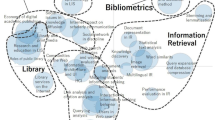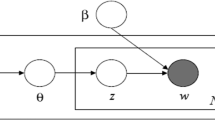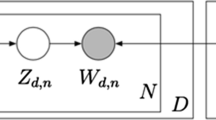Abstract
This paper offers an overview of the bibliometric study of the domain of library and information science (LIS), with the aim of giving a multidisciplinary perspective of the topical boundaries and the main areas and research tendencies. Based on a retrospective and selective search, we have obtained the bibliographical references (title and abstract) of academic production on LIS in the database LISA in the period 1978–2014, which runs to 92,705 documents. In the context of the statistical technique of topic modeling, we apply latent Dirichlet allocation, in order to identify the main topics and categories in the corpus of documents analyzed. The quantitative results reveal the existence of 19 important topics, which can be grouped together into four main areas: processes, information technology, library and specific areas of information application.














Similar content being viewed by others
References
Arun, R., Suresh, V., Veni Madhavan, C. E., Narasimha Murthy, M. N., Zaki, M. J., Yu, J. X., et al. (2010). On finding the natural number of topics with latent Dirichlet allocation: Some observations. In Advances in knowledge discovery and data mining: 14th Pacific-Asia conference, PAKDD 2010 (pp. 391–402). Hyderabad. http://dx.doi.org/10.1007/978-3-642-13657-3_43. Accessed January 12, 2017.
Åström, F. (2002). Visualizing library and information science concept spaces through keyword and citation based maps and clusters Emerging frameworks and methods. CoLIS4: Proceedings of the fourth international conference on conceptions of library and information (pp. 185–197). Libraries Unlimited: Greenwood Village, CO.
Åström, F. (2007). Changes in the LIS research front: Time-sliced cocitation analyses of LIS journal articles, 1990–2004. Journal of the American Society for Information Science and Technology, 58, 947–957.
Atkins, S. E. (1988). Subject trends in library and information science research, 1975–1984. Library trends, 36, 633–658.
Bates, M. J. (1999). The invisible substrate of information science. Journal of the Association for Information Science and Technology, 50(12), 1043–1050.
Bates, M. J., & Maack, M. N. (2010). Encyclopedia of library and information sciences (p. 3). New York: CRC Press.
Bauer, J., Leydesdorff, L., & Bornmann, L. (2015). Highly cited papers in library and information science (LIS): Authors, institutions, and network structures. Journal of the Association for Information Science and Technology, 67(12), 3095–3100.
Blei, D. M. (2012). Probabilistic topic models. Communications of the ACM, 55, 77–84.
Blei, D., Ng, A., & Jordan, M. (2003). Latent dirichlet allocation. The Journal of Machine Learning Research, 3, 993–1022.
Blessinger, K., & Frasier, M. (2007). Analysis of a decade in library literature: 1994–2004. College & Research Libraries, 68, 155–169.
Blessinger, K., & Hrycaj, P. (2010). Highly cited articles in library and information science: An analysis of content and authorship trends. Library & Information Science Research, 32, 156–162.
Buckland, M. (2012). What kind of science can information science be? Journal of the American Society for Information Science and Technology, 63, 1–7.
Buckland, M., & Liu, Z. (1998). History of information science. Historical studies in information science, 1998, 272–295.
Burke, C. (2007). History of information science. Annual Review of Information Science and Technology, 41, 3–53.
Chang, J., & Blei, D. M. (2009). Relational topic models for document networks. In AIStats (Vol. 9, pp. 81–88). http://www.jmlr.org/proceedings/papers/v5/chang09a/chang09a.pdf. Accessed March 15, 2017.
Chang, Y. L., & Chien, J. T. (2009). Latent dirichlet learning for document summarization. In 2009 IEEE international conference on acoustics, speech and signal processing (pp. 1689–1692). Taipei. doi:10.1109/ICASSP.2009.4959927.
Chang, Y. W., & Huang, M. H. (2012). A study of the evolution of interdisciplinarity in library and information science: Using three bibliometric methods. Journal of the American Society for Information Science and Technology, 63, 22–33.
Choo, C. W. (2002). Information management for the intelligent organization: The art of scanning the environment. Medford, NJ: The American Society for Information Science.
Chua, A. Y., & Yang, C. C. (2008). The shift towards multi-disciplinarity in information science. Journal of the American Society for Information Science and Technology, 59, 2156–2170.
Cronin, B. (1995). Shibboleth and substance in North American library and information science education. Libri, 45, 45–63.
Cronin, B. (2008). The sociological turn in information science. Journal of Information Science, 34(4), 465–475.
Dervin, B., & Nilan, M. (1986). Information needs and uses. Annual Review of Information Science and Technology, 21, 3–33.
Dillon, A. (2007). LIS as a research domain: Problems and prospects. Information Research, 12(4), 1–8.
Dillon, A., & Norris, A. (2005). Crying wolf: An examination and reconsideration of the perception of crisis in LIS education. Journal of Education for Library and Information Science, 46(4), 280–298.
Ding, Y., Chowdhury, G. G., & Foo, S. (2001). Bibliometric cartography of information retrieval research by using co-word analysis. Information Processing and Management, 37(6), 817–842.
Furner, J. (2015). Information science is neither. Library Trends, 63(3), 362–377.
Gilchrist, A. (1969). Library and information science abstracts: A brief progress report. Aslib Proceedings, 21(8), 325–327.
Gilchrist, A., & Presanis, A. (1971). Library and information science abstracts: The first two years. Aslib Proceedings, 23(5), 251–256.
Griffiths, T. L., & Steyvers, M. (2004). Finding scientific topics. Proceedings of the National Academy of Sciences, 101(1), 5228–5235.
Harter, S. P., & Hooten, P. A. (1992). Information science and scientists: “JASIS”, 1972–1990. Journal of the American Society for Information Science, 43(9), 583–593.
Hawkins, D. T. (2001). Information science abstracts: Tracking the literature of information science. Part 1: Definition and map. Journal of the American Society for Information Science and Technology, 52(1), 44–53.
Hawkins, D. T., Larson, S. E., & Caton, B. Q. (2003). Information science abstracts: Tracking the literature of information science. Part 2: A new taxonomy for information science. Journal of the American Society for Information Science and Technology, 54(8), 771–781.
Hidayat, E. Y., Firdausillah, F., Hastuti, K., Dewi, I. N., & Azhari, A. (2015). Automatic text summarization using latent drichlet allocation (LDA) for document clustering. International Journal of Advances in Intelligent Informatics, 1(3), 132–139.
Hjørland, B., & Albrechtsen, H. (1995). Toward a new horizon in information science: Domain-analysis. Journal of the American Society for Information Science, 46(6), 400–425.
Hjørland, B., & Hjørland, B. (2005). Empiricism, rationalism and positivism in library and information science. Journal of Documentation, 61(1), 130–155.
Hobbs, R., & Jensen, A. (2009). The past, present, and future of media literacy education. Journal of Media Literacy Education, 1(1), 1–11.
Hofmann, T. (1999). Probabilistic latent semantic indexing. In Proceedings of SIGIR’99 (pp. 50–57).
Ingwersen, P. (1992). Information and information science in context. Libri, 42(2), 99–135.
Janssens, F., Leta, J., Glänzel, W., & De Moor, B. (2006). Towards mapping library and information science. Information Processing and Management, 42(6), 1614–1642.
Jiang, Y., Jia, A., Feng, Y., & Zhao, D. (2012). Recommending academic papers via users’ reading purposes. In Proceedings of the sixth ACM conference on recommender systems (pp. 241–244). Dublin. doi:10.1145/2365952.2366004.
Julien, H., Pecoskie, J. J., & Reed, K. (2011). Trends in information behavior research, 1999–2008: A content analysis. Library and Information Science Research, 33(1), 19–24.
Kellner, D., & Share, J. (2005). Toward critical media literacy: Core concepts, debates, organizations, and policy. Discourse: Studies in the Cultural Politics of Education, 26(3), 369–386.
Kim, S. J., & Jeong, D. Y. (2006). An analysis of the development and use of theory in library and information science research articles. Library and Information Science Research, 28(4), 548–562.
Klavans, R., & Boyack, K. W. (2011). Using global mapping to create more accurate document-level maps of research fields. Journal of the American Society for Information Science and Technology, 62(1), 1–18.
Koufogiannakis, D., Slater, L., & Crumley, E. (2004). A content analysis of librarianship research. Journal of Information Science, 30(3), 227–239.
Landauer, T. K., Foltz, P. W., & Laham, D. (1998). Introduction to latent semantic analysis. In Discourse processes (Vol. 25, pp. 259–284). http://net.pku.edu.cn/~course/cs220/reading/intro_to_LSA.pdf. Accessed March 15, 2017.
Lau, J., del Rio, B., Chevillotte, S. F., Fidzani, B. T., Africa, S., Lau, J. M., et al. (2007). Information literacy: An international state-of-the art report. Mexico: InfoLit Global IFLA. http://www.ifap.ru/pr/2007/070824aa.pdf. Accessed January 12, 2017.
Lee, Y. S., Lo, R., Chen, C. Y., Lin, P. C., & Wang, J. C. (2015). News topics categorization using latent dirichlet allocation and sparse representation classifier. In 2015 IEEE international conference consumer electronics-Taiwan (ICCE-TW) (pp. 136–137). Taiwan.
Levitt, J. M., & Thelwall, M. (2009). The most highly cited library and information science articles: Interdisciplinarity, first authors and citation patterns. Scientometrics, 78(1), 45–67.
Li, F., Li, M., Guan, P., Ma, S., & Cui, L. (2015). Mapping publication trends and identifying hot spots of research on internet health information seeking behavior: A quantitative and co-word biclustering analysis. Journal of medical Internet research, 17(3), e81. doi:10.2196/jmir.3326.
Li, W., & McCallum, A. (2006). Pachinko allocation: DAG-structured mixture models of topic correlations. In Proceedings of the 23rd international conference on machine learning ICML ‘06, 2006 (pp. 577–584). New York: ACM.
Lipetz, B. A. (1999). Aspects of JASIS authorship through five decades. Journal of American Society for Information Science, 50(11), 994–1003.
Liu, J. (2003). A bibliometric study: Author productivity and co-authorship features of JASIST 2001–2002. Mississippi Libraries, 67(4), 110–112.
Maskeri, G., Sarkar, S., & Heafield, K. (2008). Mining business topics in source code using latent dirichlet allocation. In Proceedings of the 1st India software engineering conference (pp. 113–120). Hyderabad. doi:10.1145/1342211.1342234.
McCallum, A. K. (2002). MALLET: A machine learning for language toolkit. http://mallet.cs.umass.edu. Accessed March 15, 2017.
McCallum, A., Wang, X., & Corrada-Emmanuel, A. (2007). Topic and role discovery in social networks with experiments on Enron and academic email. Journal of Artificial Intelligence Research, 30, 249–272.
Miksa, F. L. (1985). Machlup’s categories of knowledge as a framework for viewing library and information science history. Journal of Library History, 20(2), 157–172.
Milojevic, S., Sugimoto, C. R., Yan, E., & Ding, Y. (2011). The cognitive structure of library and information science: Analysis of article title words. Journal of the American Society for Information Science and Technology, 62(10), 1933–1953.
Mukherjee, B. (2009). Scholarly research in LIS open access electronic journals: A bibliometric study. Scientometrics, 80(1), 167–194.
Nallapati, R. & Cohen, W. (2008). Link-PLSA-LDA: A new unsupervised model for topics and influence in blogs. International Conference for Weblogs and Social Media, 2008. https://vvvvw.aaai.org/Papers/ICWSM/2008/ICWSM08-018.pdf. Accessed March 15, 2017.
Newman, D., Chemudugunta, C., Smyth, P., & Steyvers, M. (2006). Analyzing entities and topics in news articles using statistical topic models. In Intelligence and security informatics: IEEE international conference on intelligence and security informatics, ISI 2006 (pp. 93–104). San Diego, CA.
Newman, D. J., & Block, S. (2006). Probabilistic topic decomposition of an eighteenth-century American newspaper. Journal of the American Society for Information Science and Technology, 57(6), 753–767. http://www.ics.uci.edu/~newman/pubs/JASIST_Newman.pdf. Accessed March 15, 2017.
Nolin, J., & Åström, F. (2010). Turning weakness into strength: Strategies for future LIS. Journal of Documentation, 66(1), 7–27.
Park, T. K. (2010). D-Lib Magazine: its first 13 years. In D-Lib magazine, 16(1–2). http://www.dlib.org/dlib/january10/park/01park.html. Accessed January 12, 2017.
ProQuest (2016). Library and information science abstracts (LISA): About. http://proquest.libguides.com/lisa. Accessed January 12, 2017.
Rowley, J. (1998). Towards a framework from information management. International Journal of Information Management, 18(5), 359–369.
Saracevic, T. (1995). Interdisciplinary nature of information science. Ciência da Informação, 24(1), 36–41.
Saracevic, T. (1999). Information science. Journal of American Association for Information Science, 50(12), 1051–1063.
Searing, S. E. (2012). Shaping the librarian’s library: Collecting to support LIS. In Library collection development for professional programs: Trends and best practices (pp. 88–111). Hershey, PA.
Shawn, G., & Milligan, I. (2012). Review of MALLET, produced by Andrew Kachites McCallum. Journal of Digital Humanities, 2(1). http://journalofdigitalhumanities.org/2-1/review-mallet-by-ian-milligan-and-shawn-graham/. Accessed March 15, 2017.
Shera, J. H. (1970). Sociological foundations of librarianship. New York: Asia Publishing House.
Sin, S. C. J. (2011). Longitudinal trends in internationalisation, collaboration types, and citation impact: A bibliometric analysis of seven LIS journals (1980–2008). Journal of Library and Information Science Studies, 9, 27–49.
Smeaton, A. F., Keogh, G., Gurrin, C., McDonald, K., & Sødring, T. (2002). Analysis of papers from twenty-five years of SIGIR conferences: What have we been doing for the last quarter of a century? ACM SIGIR Forum, 36(2), 39–43.
Sugimoto, C. R., Li, D., Russell, T. G., Finlay, S. C., & Ding, Y. (2011). The shifting sands of disciplinary development: Analyzing North American library and information science dissertations using latent Dirichlet allocation. Journal of the American Society for Information Science and Technology, 62(1), 185–204.
Sugimoto, C. R., & McCain, K. W. (2010). Visualizing changes over time: A history of information retrieval through the lens of descriptor tri-occurrence mapping. Journal of Information Science, 36(4), 481–493.
Swain, D. K., Jena, K. L., & Mahapatra, R. K. (2012). Interlending and document supply: A bibliometric study from 2001 to 2010. Webology, 9(2), 51–60.
UNESCO. (2013). Global media and information literacy assessment framework: Country readiness and competencies. Paris: Unesco. http://unesdoc.unesco.org/images/0022/002246/224655e.pdf. Accessed January 12, 2017.
Vakkari, P., & Godden, I. (1994). Library and information science: Its content and scope. Advances in Librarianship, 18, 1–55.
Van Den Besselaar, P., & Heimeriks, G. (2006). Mapping research topics using word-reference co-occurrences: A method and an exploratory case study. Scientometrics, 68(3), 377–393.
Wallach, H. M., Mimno, D. M., & McCallum, A. (2009). Rethinking LDA: Why priors matter. In Advances in neural information processing systems (pp. 1973–1981). http://papers.nips.cc/paper/3854rethinking-lda-why-priors-matter.pdf. Accessed March 15, 2017.
Webber, S. (2003). Information science in 2003: A critique. Journal of Information Science, 29(4), 311–330.
Weng, J., Lim, E. P., Jiang, J., & He, Q. (2010). Twitterrank: Finding topic-sensitive influential twitterers. In Proceedings of the third ACM international conference on web search and data mining (pp. 261–270). New York.
Wilson, T. D. (1984). The cognitive approach to information seeking behaviour and information use. Social Science Information Studies, 4(2/3), 197–204.
Zhang, P., & Benjamin, R. I. (2007). Understanding information related fields: A conceptual framework. Journal of American Society for Information Science and Technology, 58(13), 1934–1947.
Zhang, P., Yan, J. L. S., & Hassman, K. D. (2013). The intellectual characteristics of the information field: Heritage and substance. Journal of the American Society for Information Science and Technology, 64(12), 2468–2491.
Zhao, W., Chen, J. J., Perkins, R., Liu, Z., Ge, W., Ding, Y., et al. (2015). A heuristic approach to determine an appropriate number of topics in topic modeling. BMC Bioinformatics, 16(Suppl 13), S8. http://doi.org/10.1186/1471-2105-16-S13-S8. Accessed March 15, 2017.
Zins, C. (2007). Conceptions of information science. Journal of the American Society for Information Science and Technology, 58(3), 335–350.
Author information
Authors and Affiliations
Corresponding author
Rights and permissions
About this article
Cite this article
Figuerola, C.G., García Marco, F.J. & Pinto, M. Mapping the evolution of library and information science (1978–2014) using topic modeling on LISA. Scientometrics 112, 1507–1535 (2017). https://doi.org/10.1007/s11192-017-2432-9
Received:
Published:
Issue Date:
DOI: https://doi.org/10.1007/s11192-017-2432-9




